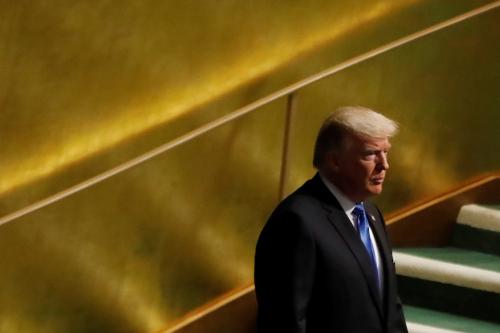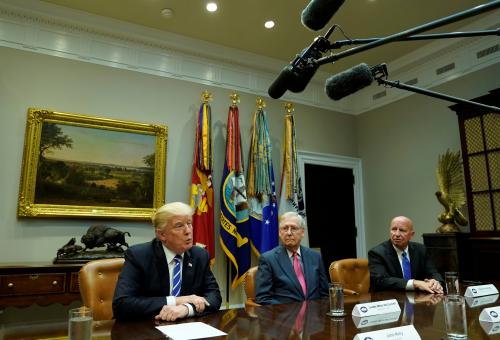This article originally appeared on Marketwatch on September 29, 2017.
While President Donald Trump’s latest tax plan moves in the right direction, the math still does not work.
Earlier this week in a MarketWatch commentary, I argued that Congress would likely be obliged to lower the corporate tax rate, and the related rate on partnership business income, to 25 percent rather than 15 percent. On Wednesday, Trump announced a tax framework with a 20 percent rate for corporations and a 25 percent rate for partnership business income.
So the president is halfway to reality. The Trump tax plan still costs $500 billion more than the $1.5 trillion deficit limit in the Senate budget resolution, which is needed to pass tax bills by 51 Senators instead of the usual 60. That problem can be simply solved by cutting the corporate tax rate to 25 percent from 35 percent — which will still be a boon to corporate America.
Let’s go over the numbers. Cutting the corporate tax rate to 20 percent from 35 percent costs $1.8 trillion.
Add another $660 billion if owners of partnerships are taxed at 25 percent, rather than the higher rate for ordinary income of individuals. The revenues lost by the cuts total $2.46 trillion over 10 years.
Can this $2.46 trillion be reduced by repealing existing tax preferences of business? As explained in my prior article, if Congress repealed all the industry-specific preferences in the Tax Code, that would raise $270 billion over 10 years. In addition, the Trump plan will limit the net interest of corporations, and perhaps other businesses. This could be worth about $180 billion over 10 years. The Trump plan raises another $150 billion by allowing companies to repatriate past foreign profits at a low rate.
So we have $2.46 in revenues lost from tax cuts and $600 billion in potential revenue gains ($270 billion +$180 billion + $150 billion), for a net budget deficit of $1.86 trillion over 10 years.
But the Trump Plan includes a new corporate goodie — allowing companies to immediately expense their capital expenditures, rather than deducting them ratably over their useful lives. This probably raises the budget deficits on the business side to $2.2 trillion.
Can that $2.2 trillion on the business side be reduced by a large net revenue gain on the individual side? At most the individual side could produce a net revenue gain of $200 billion. So the total deficit produced by the Trump tax plan could be $2 trillion — $500 billion more than the $1.5 trillion the Senate budget resolution allows.
It turns out that if Congress were to cut the corporate tax rate to 25 percent instead of 20 percent, that would raise the needed $500 billion in additional tax revenues. Alternatively, Congress could try to repeal other tax preferences enjoyed by business. But realistically, Congress will be hard pressed to eliminate all the preferences identified in the Trump plan.
In short, even under the most optimistic assumptions about repealing existing tax preferences, Congress is likely to cut the corporate tax rate to 25 percent, rather than the proposed 20 percent, in order to meet the terms of the budget resolution. Nevertheless, 25 percent is a lot better than 35 percent.
For domestic income, effective corporate tax rates would be substantially lower than 25 percent — because the Trump tax plan continues the research-and-development tax credit as well as other business preferences, and adds immediate expensing of capital expenditures. Moreover, the 25 percent headline rate on domestic income would be part of a legislative package that would allow U.S. companies to repatriate future foreign profits without additional U.S. corporate tax, except if they were earned in low- or no-tax jurisdictions.
While corporate executives obviously would welcome a lower tax rate than 25 percent, they will be learning the fundamental lesson of Washington politics — the best is the enemy of the good.
Robert Pozen has been a nonresident senior fellow at Brookings since 2010. In 2015, he generously committed to endow the Director’s Chair for the Urban-Brookings Tax Policy Center. Until 2010, Pozen was executive chairman of MFS Investment Management and, before 2002, served in various positions at Fidelity Investments. He did not receive financial support from any firm or person for this article or from any firm or person with a financial or political interest in this article. He is currently not an officer, director, or board member of any organization with an interest in this article.
The Brookings Institution is committed to quality, independence, and impact.
We are supported by a diverse array of funders. In line with our values and policies, each Brookings publication represents the sole views of its author(s).






Commentary
Op-edTrump’s tax plan is one big step from reality
October 2, 2017